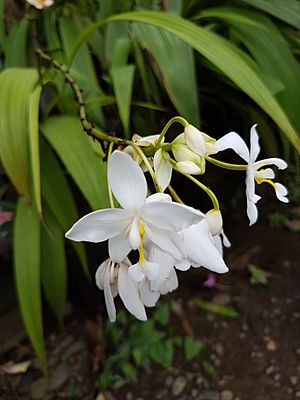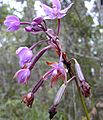Large purple orchid facts for kids
Quick facts for kids Large purple orchid |
|
|---|---|
 |
|
| Spathoglottis plicata flowers | |
 |
|
| Spathoglottis plicata white cultivar | |
| Scientific classification | |
| Genus: |
Spathoglottis
|
| Species: |
plicata
|
| Synonyms | |
|
|
The Spathoglottis plicata, also known as the Philippine ground orchid or large purple orchid, is a beautiful plant. It is an evergreen plant, meaning it stays green all year. It grows in the ground, not on trees.
This orchid has many pseudobulbs, which are like swollen stems that store water and nutrients. It also has three or four large, folded leaves. Its flowers are usually pink to purple and face upside down, which is called resupinate.
You can find this orchid in warm, tropical, and subtropical parts of Asia, Australia, and the western Pacific. This includes places like Tonga and Samoa.
Contents
What it Looks Like
The Spathoglottis plicata is an evergreen plant that grows in clumps. It has crowded pseudobulbs that are about 4 to 6 centimeters (1.5 to 2.5 inches) long. These pseudobulbs are also about 2 to 4 centimeters (0.8 to 1.5 inches) wide.
Each pseudobulb has three or four leaves that are pleated, or folded like a fan. These leaves can be 50 to 90 centimeters (20 to 35 inches) long. They grow on a stalk that is 8 to 15 centimeters (3 to 6 inches) long.
The plant produces a tall, hairy stem that can grow up to 50 to 100 centimeters (20 to 39 inches) tall. On this stem, you can find up to forty flowers. Each flower is deep pink to purple and measures about 3.5 to 5.5 centimeters (1.4 to 2.2 inches) across.
Flower Parts
The flower has different parts. The top petal, called the dorsal sepal, is about 2 to 3 centimeters (0.8 to 1.2 inches) long. The side petals, called lateral sepals, are a bit narrower.
The main petals are about the same length as the sepals but are much wider. The most interesting part is the labellum, which is a special lip-shaped petal. It looks like a "T" and is similar in size to the dorsal sepal. It has three parts, with the side parts standing almost straight up.
At the very top of the flower's central part, called the column, there is a small cap. Under this cap, you can see many tiny yellow pollen grains.
Life Cycle
In Australia, these orchids usually bloom from September to April. In places like China and New Guinea, they can flower almost any month of the year.
After a flower is pollinated, it forms a fruit. This fruit is a capsule that is about 3 millimeters (0.1 inches) long. It is green and shaped like a cylinder.
The seeds inside the capsule take about six weeks to grow. When the seeds are ready, the capsule splits open. Thousands of tiny seeds are then carried away by the wind, helping the plant spread.
Naming the Orchid
The Spathoglottis plicata was officially named in 1825. This was done by a scientist named Carl Ludwig Blume. He wrote about it in a book called Bijdragen tot de flora van Nederlandsch Indië.
The second part of its name, plicata, comes from a Latin word. It means "folded," which refers to the pleated leaves of the orchid.
Where it Grows
The large purple orchid can be found in many places. These include Taiwan, southern India, Indonesia, Japan, Malaysia, New Guinea, the Philippines, Sri Lanka, Thailand, Vietnam, Australia, Tonga, and Samoa.
In Australia, it grows from Cooktown all the way to the Jardine River on Cape York Peninsula.
This orchid likes to grow in wet areas that might flood sometimes. It also likes sunny spots near swamps, wet ground where water seeps out, and small streams. As mentioned, in Australia, its flowering season is from September to April.
Protecting the Orchid
The Spathoglottis plicata was once listed as "vulnerable." This meant it was at risk of becoming extinct. This listing was under a law called the Environment Protection and Biodiversity Conservation Act 1999. However, in 2010, it was removed from this list. This means it is no longer considered vulnerable.
Growing Orchids at Home
The Spathoglottis plicata is a popular orchid for growing in gardens. People have grown and chosen different types of this orchid. The most common type has bright purple flowers. Some types have lighter purple or pale purple flowers. There is even a rare pure white type called ‘Penang White’.
This orchid is easy to grow and grows quickly. Because of this, it is often used to create new types of orchids. Scientists cross it with other mountain Spathoglottis orchids that are harder to grow. This helps them create new and interesting varieties.
The first Spathoglottis hybrid (a mix of two different types) was made in 1932. A scientist named Richard Eric Holttum crossed S. plicata with S. aurea. He named this new orchid Spathoglottis 'Primrose'.
Another type, ‘Dwarf Legion’, is a mix of 'Primrose' and S. tomentosa. This dwarf (small) orchid can produce flowers in many colors, from pink to yellow, and even pure cream.
If you want to grow Spathoglottis plicata, you need to plant it in soil that drains water well and has good air circulation. The top part of the pseudobulb should be above the ground. It's also a good idea to give it diluted plant food often.
Images for kids





